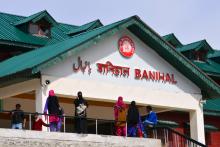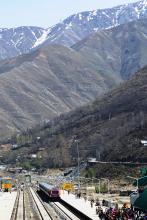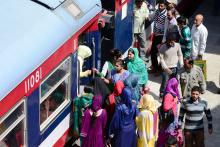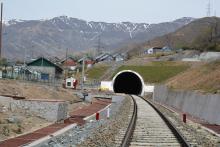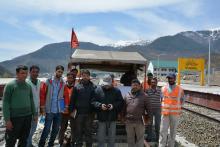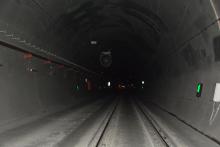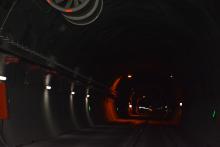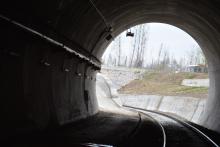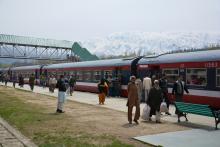Rail Tunnel to Paradise
Since Independence, the Indian Railways have wanted to link Kashmir Valley with the rest of the country. But the greatest challenge was the mighty Pir Panjal mountain range, towering between the Jammu and Kashmir regions. While the Jawahar road tunnel through this range was opened in 1956 at an elevation of 2200 metres to connect the two regions, yet during winter snowfall, the road was often paralysed, cutting off Kashmir valley from the rest of the country.
This problem was finally solved by the Indian Railways in 2013, when the railway tunnel between Banihal in Jammu side and Qazigund in the Kashmir valley was opened to traffic. This has enabled the reduction of the travel time from Banihal to Srinagar to only about 2 hours. The tunnel being at an elevation of only 1760 metres above MSL, much lower than the road tunnel, it keeps rail traffic open all 365 days, even during peak winter.
The IR’s USBRL [Udhampur-Srinagar-Baramulla Rail Link] project team, consisting of engineers of the Northern Railway, Konkan Railway Corporation Ltd. [KRCL] and IRCON International have used path-breaking, innovative, technological solutions to achieve success while boring through these inhospitable and seismologically unstable mountains. I had the opportunity to inspect the tunnel on motor trolley during April 2014, a few months after its commissioning. The tunnel is 11.21 km in length, with a broad-gauge railway track embedded. The ventilation and emergency features within the tunnel are unprecedented, with giant circulators, pumping in fresh air from shafts bored into the rock at periodic intervals. The tunnel is 8.4 metres wide with a height of 7.39 metres. A 3-metre wide concrete road runs along the complete length of the tunnel, especially constructed for evacuation in case of emergency and for disaster management. At every few metres, emergency telephones and relief equipment are installed for safety of trains and passengers.
While waiting for the train to arrive at Banihal station from Srinagar on that morning of April, 2014, I met two young high-school students from a poor family of farmers living in Banihal. They told me that since there were no good schools in Banihal, they studied in Srinagar. Earlier, they had to live in a hostel in Srinagar itself for their studies and could come home only during holidays. This was a severe financial burden on their parents. But, with construction of the tunnel and running of the train, they now attend school every day from their home. This has saved the family’s hard-earned money for a secure future!
This story moved me very much and I felt proud to be part of the Indian Railways’ Team.
Rail Tunnel to Paradise
Since Independence, the Indian Railways have wanted to link Kashmir Valley with the rest of the country. But the greatest challenge was the mighty Pir Panjal mountain range, towering between the Jammu and Kashmir regions. While the Jawahar road tunnel through this range was opened in 1956 at an elevation of 2200 metres to connect the two regions, yet during winter snowfall, the road was often paralysed, cutting off Kashmir valley from the rest of the country.
This problem was finally solved by the Indian Railways in 2013, when the railway tunnel between Banihal in Jammu side and Qazigund in the Kashmir valley was opened to traffic. This has enabled the reduction of the travel time from Banihal to Srinagar to only about 2 hours. The tunnel being at an elevation of only 1760 metres above MSL, much lower than the road tunnel, it keeps rail traffic open all 365 days, even during peak winter.
The IR’s USBRL [Udhampur-Srinagar-Baramulla Rail Link] project team, consisting of engineers of the Northern Railway, Konkan Railway Corporation Ltd. [KRCL] and IRCON International have used path-breaking, innovative, technological solutions to achieve success while boring through these inhospitable and seismologically unstable mountains. I had the opportunity to inspect the tunnel on motor trolley during April 2014, a few months after its commissioning. The tunnel is 11.21 km in length, with a broad-gauge railway track embedded. The ventilation and emergency features within the tunnel are unprecedented, with giant circulators, pumping in fresh air from shafts bored into the rock at periodic intervals. The tunnel is 8.4 metres wide with a height of 7.39 metres. A 3-metre wide concrete road runs along the complete length of the tunnel, especially constructed for evacuation in case of emergency and for disaster management. At every few metres, emergency telephones and relief equipment are installed for safety of trains and passengers.
While waiting for the train to arrive at Banihal station from Srinagar on that morning of April, 2014, I met two young high-school students from a poor family of farmers living in Banihal. They told me that since there were no good schools in Banihal, they studied in Srinagar. Earlier, they had to live in a hostel in Srinagar itself for their studies and could come home only during holidays. This was a severe financial burden on their parents. But, with construction of the tunnel and running of the train, they now attend school every day from their home. This has saved the family’s hard-earned money for a secure future!
This story moved me very much and I felt proud to be part of the Indian Railways’ Team.
Text and Photos: Sanjoy Mookerjee

